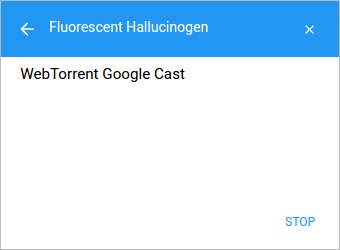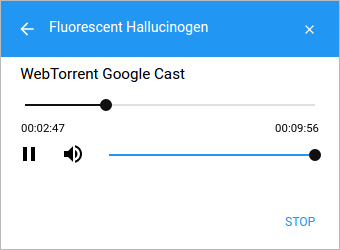Как добавить стандартные элементы управления мультимедиа в приложение Google Cast?
Я разрабатываю специальное приложение-получатель Google Cast с использованием WebTorrent ( https://webtorrent.io/, https://github.com/feross/webtorrent) и приложения-отправителя Google Cast с использованием JavaScript (Chrome) SDK.
Идея моего приложения заключается в отправке торрент-идентификатора (магнитный URI, как magnet:?xt=urn:btih:6a9759bffd5c0af65319979fb7832189f4f3c35d или HTTP/HTTPS URL к файлу *.torrent, например https://webtorrent.io/torrents/sintel.torrent) из отправителя Google Cast в приемник Google Cast и использование WebTorrent в приемнике Google Cast для отображения мультимедиа (видео или аудио) из торрента.
Обратите внимание, что торрент-идентификатор не является прямым URL-адресом медиа-файла.
Сейчас я использую пространство имен Google Cast и messageBus для отправки и получения торрент-идентификатора.
WebTorrent API предоставляет 2 способа отображения мультимедиа:
- добавить его в DOM, используя
file.appendTo: https://webtorrent.io/docs#-file-appendto-rootelem-function-callback-err-elem- - визуализировать непосредственно в данный элемент (или CSS-селектор), используя
file.renderTo: https://webtorrent.io/docs#-file-renderto-elem-function-callback-err-elem-
Вот код моего получателя:
<html>
<head>
<script src="https://www.gstatic.com/cast/sdk/libs/receiver/2.0.0/cast_receiver.js"></script>
<script src="https://cdn.jsdelivr.net/webtorrent/latest/webtorrent.min.js"></script>
</head>
<body>
<video autoplay id='media' />
<script>
window.mediaElement = document.getElementById('media');
window.mediaManager = new cast.receiver.MediaManager(window.mediaElement);
window.castReceiverManager = cast.receiver.CastReceiverManager.getInstance();
window.messageBus = window.castReceiverManager.getCastMessageBus('urn:x-cast:com.google.cast.sample.helloworld');
window.messageBus.onMessage = function(event) {
displayVideo(event.data);
// Inform all senders on the CastMessageBus of the incoming message event
// sender message listener will be invoked
window.messageBus.send(event.senderId, event.data);
};
function displayVideo(torrentId) {
var client = new WebTorrent();
client.add(torrentId, function (torrent) {
var file = torrent.files[0];
file.renderTo('video');
});
}
window.castReceiverManager.start();
</script>
</body>
</html>
Вот код моего отправителя:
<!--
Copyright (C) 2014 Google Inc. All Rights Reserved.
Licensed under the Apache License, Version 2.0 (the "License");
you may not use this file except in compliance with the License.
You may obtain a copy of the License at
http://www.apache.org/licenses/LICENSE-2.0
Unless required by applicable law or agreed to in writing, software
distributed under the License is distributed on an "AS IS" BASIS,
WITHOUT WARRANTIES OR CONDITIONS OF ANY KIND, either express or implied.
See the License for the specific language governing permissions and
limitations under the License.
-->
<html>
<head>
<style type="text/css">
html, body, #wrapper {
height:100%;
width: 100%;
margin: 0;
padding: 0;
border: 0;
}
#wrapper td {
vertical-align: middle;
text-align: center;
}
input {
font-family: "Arial", Arial, sans-serif;
font-size: 40px;
font-weight: bold;
}
.border {
border: 2px solid #cccccc;
border-radius: 5px;
}
.border:focus {
outline: none;
border-color: #8ecaed;
box-shadow: 0 0 5px #8ecaed;
}
</style>
<script type="text/javascript" src="https://www.gstatic.com/cv/js/sender/v1/cast_sender.js"></script>
<script type="text/javascript">
var applicationID = 'F5304A3D';
var namespace = 'urn:x-cast:com.google.cast.sample.helloworld';
var session = null;
/**
* Call initialization for Cast
*/
if (!chrome.cast || !chrome.cast.isAvailable) {
setTimeout(initializeCastApi, 1000);
}
/**
* initialization
*/
function initializeCastApi() {
var sessionRequest = new chrome.cast.SessionRequest(applicationID);
var apiConfig = new chrome.cast.ApiConfig(sessionRequest,
sessionListener,
receiverListener);
chrome.cast.initialize(apiConfig, onInitSuccess, onError);
};
/**
* initialization success callback
*/
function onInitSuccess() {
appendMessage("onInitSuccess");
}
/**
* initialization error callback
*/
function onError(message) {
appendMessage("onError: "+JSON.stringify(message));
}
/**
* generic success callback
*/
function onSuccess(message) {
appendMessage("onSuccess: "+message);
}
/**
* callback on success for stopping app
*/
function onStopAppSuccess() {
appendMessage('onStopAppSuccess');
}
/**
* session listener during initialization
*/
function sessionListener(e) {
appendMessage('New session ID:' + e.sessionId);
session = e;
session.addUpdateListener(sessionUpdateListener);
session.addMessageListener(namespace, receiverMessage);
}
/**
* listener for session updates
*/
function sessionUpdateListener(isAlive) {
var message = isAlive ? 'Session Updated' : 'Session Removed';
message += ': ' + session.sessionId;
appendMessage(message);
if (!isAlive) {
session = null;
}
};
/**
* utility function to log messages from the receiver
* @param {string} namespace The namespace of the message
* @param {string} message A message string
*/
function receiverMessage(namespace, message) {
appendMessage("receiverMessage: "+namespace+", "+message);
};
/**
* receiver listener during initialization
*/
function receiverListener(e) {
if( e === 'available' ) {
appendMessage("receiver found");
}
else {
appendMessage("receiver list empty");
}
}
/**
* stop app/session
*/
function stopApp() {
session.stop(onStopAppSuccess, onError);
}
/**
* send a message to the receiver using the custom namespace
* receiver CastMessageBus message handler will be invoked
* @param {string} message A message string
*/
function sendMessage(message) {
if (session!=null) {
session.sendMessage(namespace, message, onSuccess.bind(this, "Message sent: " + message), onError);
}
else {
chrome.cast.requestSession(function(e) {
session = e;
session.sendMessage(namespace, message, onSuccess.bind(this, "Message sent: " + message), onError);
}, onError);
}
}
/**
* append message to debug message window
* @param {string} message A message string
*/
function appendMessage(message) {
console.log(message);
var dw = document.getElementById("debugmessage");
dw.innerHTML += '\n' + JSON.stringify(message);
};
/**
* utility function to handle text typed in by user in the input field
*/
function update() {
sendMessage(document.getElementById("input").value);
}
/**
* handler for the transcribed text from the speech input
* @param {string} words A transcibed speech string
*/
function transcribe(words) {
sendMessage(words);
}
</script>
</head>
<body>
<table id="wrapper">
<tr>
<td>
<form method="get" action="JavaScript:update();">
<input id="input" class="border" type="text" size="30" onwebkitspeechchange="transcribe(this.value)" x-webkit-speech/>
</form>
</td>
</tr>
</table>
<!-- Debbugging output -->
<div style="margin:10px; visibility:hidden;">
<textarea rows="20" cols="70" id="debugmessage">
</textarea>
</div>
<script type="text/javascript">
document.getElementById("input").focus();
</script>
</body>
</html>
Проблема: получатель обрабатывает идентификатор торрента от отправителя, и видео воспроизводится, как и ожидалось. Но официальное приложение Google Cast или официальное расширение Google Cast для Chrome не отображает стандартные элементы управления мультимедиа для воспроизведения видео с целью приостановки, остановки, поиска и т. Д.
Вот что у меня есть (это скриншот стандартного встроенного модального диалога для Google Cast в последней версии Google Chrome):
Вот чего я хочу достичь (это скриншот стандартного встроенного модального диалога для Google Cast в последней версии Google Chrome):
Добавление
window.mediaElement = document.getElementById('media');
window.mediaManager = new cast.receiver.MediaManager(window.mediaElement);
за
<video autoplay id='media' />
Элемент не помогает.
Должен ли я добавить что-то к отправителю и / или получателю, чтобы добавить стандартные средства управления мультимедиа для <video autoplay id='media' /> на всех отправителей?
Может быть, есть другой способ отправки и получения торрент-идентификатора без использования пространства имен Google Cast и messageBus?
UPD
Похоже, я нашел корень моей проблемы...
Как включить средства управления мультимедиа по умолчанию для существующего воспроизводимого видео в ресивере?
Например, приложение-получатель уже воспроизводит видео:
<video autoplay id='media'
src='https://commondatastorage.googleapis.com/gtv-videos-bucket/sample/BigBuckBunny.mp4'
/>
Как включить элементы управления мультимедиа по умолчанию - рабочие кнопки "Воспроизведение / Пауза", рабочая индикатор выполнения (для всех отправителей, таких как официальное расширение Google Cast для Chrome) для этого воспроизводимого видео?
Похоже, добавление следующего кода не поможет:
window.mediaElement = document.getElementById('media');
window.mediaManager = new cast.receiver.MediaManager(window.mediaElement);
window.castReceiverManager = cast.receiver.CastReceiverManager.getInstance();
window.castReceiverManager.start();
Вот полный исходный код получателя:
<html>
<head>
<script src="https://www.gstatic.com/cast/sdk/libs/receiver/2.0.0/cast_receiver.js"></script>
</head>
<body>
<video autoplay id='media'
src='https://commondatastorage.googleapis.com/gtv-videos-bucket/sample/BigBuckBunny.mp4'
/>
<script>
window.mediaElement = document.getElementById('media');
window.mediaManager = new cast.receiver.MediaManager(window.mediaElement);
window.castReceiverManager = cast.receiver.CastReceiverManager.getInstance();
window.castReceiverManager.start();
</script>
</body>
</html>
UPD2:
Похоже, можно использовать любую текстовую строку (идентификатор торрента в моем случае) вместо медиа-URL в chrome.cast.media.MediaInfo и использовать пространство имен мультимедиа вместо использования настраиваемого пространства имен и настраиваемой шины сообщений (т. е. без использования https://developers.google.com/cast/docs/reference/receiver/cast.receiver.CastReceiverManager и https://developers.google.com/cast/docs/reference/receiver/cast.receiver.CastMessageBus и https://developers.google.com/cast/docs/reference/chrome/chrome.cast.Session):
function cast() {
url = 'magnet:?xt=urn:btih:6a9759bffd5c0af65319979fb7832189f4f3c35d';
chrome.cast.requestSession(function(session) {
var mediaInfo = new chrome.cast.media.MediaInfo(url);
//mediaInfo.contentType = 'video/mp4';
//mediaInfo.contentType = 'audio/mpeg';
//mediaInfo.contentType = 'image/jpeg';
var request = new chrome.cast.media.LoadRequest(mediaInfo);
request.autoplay = true;
session.loadMedia(request, function() {}, onError);
}, onError);
}
Но как справиться с этим на ресивере в этом случае?
1 ответ
На самом деле существует руководство Google Cast UX, в котором говорится, что приложение отправителя должно предоставлять кнопку Cast верхнего уровня. Существует три способа поддержки кнопки Cast, которые были полностью обсуждены при разработке приложений для Android Sender.
- Использование MediaRouter ActionBar провайдера: android.support.v7.app.MediaRouteActionProvider
- Использование кнопки MediaRouter Cast: android.support.v7.app.MediaRouteButton
- Разработка пользовательского интерфейса с помощью MediaRouter API и MediaRouter.Callback
Чтобы показать стандартные элементы управления мультимедиа после воспроизведения мультимедиа, приложение отправителя может управлять воспроизведением мультимедиа с помощью экземпляра RemoteMediaPlayer. Шаги и примеры можно найти в документации.
Полный список всех классов, методов и событий в Google Cast Android SDK см. В Справочнике по Google Cast Android API.
Я понимаю, что прошло уже 3 года, но что меня бросает в глаза, так это то, что вам не хватает атрибута "control" в вашем теге видео! Без атрибута проигрыватель будет отображать видео, но не предоставит пользовательского интерфейса для управления воспроизведением....
Синтаксис такой же, как и для автовоспроизведения: атрибут controls является автономным и не имеет значения. Это все или ничего - стандартный набор элементов управления со стилем по умолчанию или вообще ничего... если вы создавали для браузера, вы можете опустить атрибут и создать свои собственные элементы управления, соответствующие внешнему виду и ощущениям страница. Но, судя по скриншотам, которыми вы поделились, в этом нет необходимости (и это может не работать в среде приемника Chromecast)
Правильный html ниже, и это все, что вам нужно:)
https://commondatastorage.googleapis.com/gtv-videos-bucket/sample/BigBuckBunny.mp4'/>
Пожалуйста, дайте нам знать, если и как вы закончили решение своей проблемы (и отправьте мне DM... Недавно я начал интегрировать webtorrent в платформу потокового видео, которую я создаю, и пока все хорошо, но документация довольно плохая и У меня есть несколько вопросов. Спасибо!)

